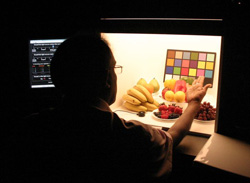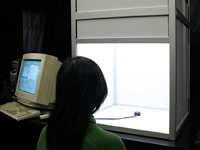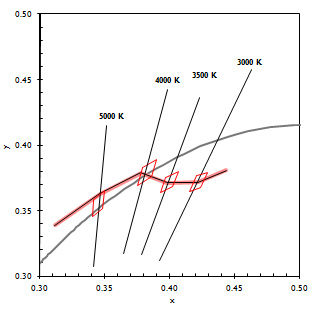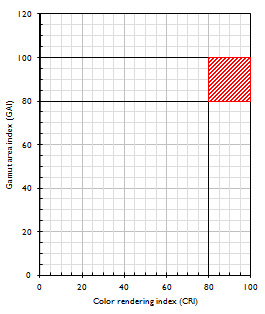Understanding White Light Source
Color Rendering and Appearance

Color rendering experiments

Experiments to investigate perceptions of white illumination hue and tint |
White light sources can be described by two major color properties: color rendering and color appearance. The lighting industry relies on two metrics to communicate these color properties: color rendering index (CRI) and correlated color temperature (CCT). CRI is used as an indicator of how similar light sources render the colors of illuminated objects with respect to a reference light source, whereas CCT is used to describe the tint of the illumination provided by the source.
Each metric conveys different information and neither is a perfect descriptor for how people will actually perceive a given light source. In recent years, studies have shown that because color rendering is a multidimensional construct, CRI by itself is not a perfect predictor of a light source's overall ability to render object colors. Similarly, CCT cannot accurately depict a light source's color appearance because of the large tolerance in allowable chromaticities for a given CCT designation.
In 2002, the LRC and ASSIST began a long-term study of subjective preferences using psychophysical experiments to understand how observers perceive white light sources and what they prefer in terms of object color rendering and the white hue or tint of a light source.
In studies of color rendering, LRC researchers found the need to describe both the "naturalness" and "vividness" of object colors, and that one metric could not do both. These studies led to the recommendation for a two-metric approach to color rendering, combining CRI with gamut area index (GAI), that could predict high satisfaction from observers of object colors. This approach was later formalized by ASSIST in its ASSIST recommends publication series.
To better understand white light source color appearance, the LRC conducted a series of experiments to measure perceptions of white illumination from light sources of different CCTs. These studies showed that perceptions of minimally tinted white illumination for sources with CCTs above 4000 K are associated with chromaticities that fall above the blackbody locus. In contrast, perceptions of minimally tinted white illumination for sources with CCTs below 4000 K are associated with chromaticities that lie well below the blackbody locus.
Research in these areas has shown that
when given a visual choice, people often prefer “white” or minimally tinted sources that provide good color rendering. To simplify the communication of the color properties of such light sources, a new designation called Class A Color Lighting has been proposed. Class A Color sources have a chromaticity on or near the line of minimum tint, good color rendering (CRI>80 and 80<GAI<100), and are consistent in chromaticity. Importantly, while the Class A Color concept is simple to understand and communicate because it avoids jargon that consumers don't understand, it still allows for identification by designers and specifiers of all of the color properties of the light source. For more details, refer to the publications below.
 
Class A Color lighting recommendations for
chromaticity tolerance (left) and CRI/GAI combination (right) for retail applications
Tools
GAI Calculator (.xls) and Instructions
Download: GAICalculator.zip
Technical Publications & Presentations
Class A Color
Freyssinier, J.P., and M.S. Rea. 2013. Class A color designation for light sources used in general illumination. Journal of Light and Visual Environment 37(2&3): 46 –50.
Rea, M.S. and J.P. Freyssinier. 2013. A proposed Class-A-colour designation of light sources used for general illumination. In: Proceedings of the 12th International AIC Colour Congress, vol. 4, pp. 1725–1728, July 8-12, 2013 New Castle Upon Tyne, UK: AIC.
Freyssinier, J.P. and M.S. Rea. 2013. The Class A color designation for light sources. Presented at 2013 DOE Solid-State Lighting R&D Workshop, January 29-31, 2013, Long Beach, Calif.
Rea, M.S. and J.P. Freyssinier. 2012. The Class A color designation for light sources. In: Proceedings of Experiencing Light 2012: International Conference on the Effects of Light on Wellbeing (Eds. Y.A.W. de Kort, W.A. IJsselsteijn, M.Aarts, A. Haans, D. Lakens, K.C.H.J. Smolders, F. Beute, L. van Rijswijk).
Freyssinier, J.P. and M.S. Rea. 2012. Class A color classification for light sources used in general illumination. Light Sources 2012: Proceedings of the 13th International Symposium on the Science and Technology of Lighting, June 24-29, 2012, Troy, New York, pp. 337–338. Sheffield, UK: Foundation for the Advancement of the Science and Technology of Light Sources.
Rea, M.S. and J. P. Freyssinier. 2012. Class A Color Classification for Light Sources Used in General Illumination. Presentation given at Capturing the Lighting Edge, October 3, 2012, Troy, NY. 
Freyssinier, J.P., and M.S. Rea. 2012. Class A lighting. Presentation given at Strategies in Light 2012, February 7-9, 2012, Santa Clara, CA. 
White Lighting
Rea, M.S. and J.P. Freyssinier. 2014. White lighting: a provisional model for predicting perceived tint in "white" illumination. Color Research and Application 39(5): 466–479; doi: 10.1002/col.21837.
Rea, M.S. and J.P. Freyssinier. 2013. White lighting: a theoretical and empirical framework. In: Proceedings of the 12th International AIC Colour Congress, vol. 2, pp. 651–654, July 8-12, 2013 New Castle Upon Tyne, UK: AIC.
Rea, M.S. and J.P. Freyssinier. 2013. White lighting for residential applications. Lighting Research and Technology 45(3): 331–344. Article first published online 27 March 2012; doi: 10.1177/1477153512442936.
Rea, M.S. and J.P. Freyssinier. 2013. White lighting. Color Research and Application 38(2): 82–92; doi: 10.1002/col.20738.
Color Rendering
Rea, M.S., and J.P. Freyssinier. 2014. Color rendering: The forest and the trees. LS14: Proceedings of the 14th International Symposium on the Science and Technology of Lighting, pp. 429-432, June 22-27, 2014, Como, Italy.
Freyssinier, J.P., and M. Rea. 2010. A two-metric proposal to specify the color-rendering properties of light sources for retail lighting. Tenth International Conference on Solid State Lighting, August 1-5, 2010, San Diego, CA, Proceedings of SPIE 7784: 77840V. 
Rea, M.S. 2010. A practical and predictive two-metric system for characterizing the color rendering properties of light sources used for architectural applications. Proceedings of SPIE 7652: 765206. 
ASSIST. 2010. ASSIST recommends: Guide to Light and Color in Retail Merchandising. Vol. 8, Iss. 1. Troy, NY: Lighting Research Center. 
ASSIST. 2010. ASSIST recommends: Recommendations for Specifying Color Properties of Light Sources for Retail Merchandising. Vol. 8, Iss. 2. Troy, NY: Lighting Research Center. 
Rea, M.S., and J.P. Freyssinier. 2010. Color rendering: Beyond pride and prejudice. Color Research and Application 35(6): 401–409.
Rea, M.S., and J.P. Freyssinier-Nova. 2008. Color rendering: A tale of two metrics. Color Research and Application 33(3): 192 –202.
Narendran, N., and L. Deng. 2002. Color rendering properties of LED light sources. Solid State Lighting II: Proceedings of SPIE 4776: 61-67.
Summary | Full-text PDF
Project Summary Sheets
Class A Color for White Lighting (2013) 
Perceptions of White Light Sources of Different Color Temperatures (2011) 
ASSIST recommends...Specifying Light Source Color for Retail (2010) 
Color Rendering: Beyond Pride and Prejudice (2009) 
Color Rendering: A Tale of Two Metrics (2007) 
Characterizing Color Properties of LED-based Reading Lights (2002) 
Media Coverage
Rea, M. and J.P. Freyssinier. 2016. CRI should never be used in efficacy regulations but a new lumen definition should. LEDs Magazine, November 2016, pp. 43–45.
Wright, M. 2012. SSL must still clear hurdles to enable mass adoption of LED lighting. LEDs Magazine March 2012: 39-48.
Dilouie, C. 2012. New metrics challenge CRI as the industry's primary tool for evaluating color rendering. Architectural Lighting, February 2012.
Whitaker, T. Search continues for replacement for Color Rendering Index. LEDs Magazine July/Aug 2010, p.59
LRC Press Release: ASSIST recommendation provides new metrics for specifying color properties in retail lighting (2010)
Sponsor
ASSIST
|


